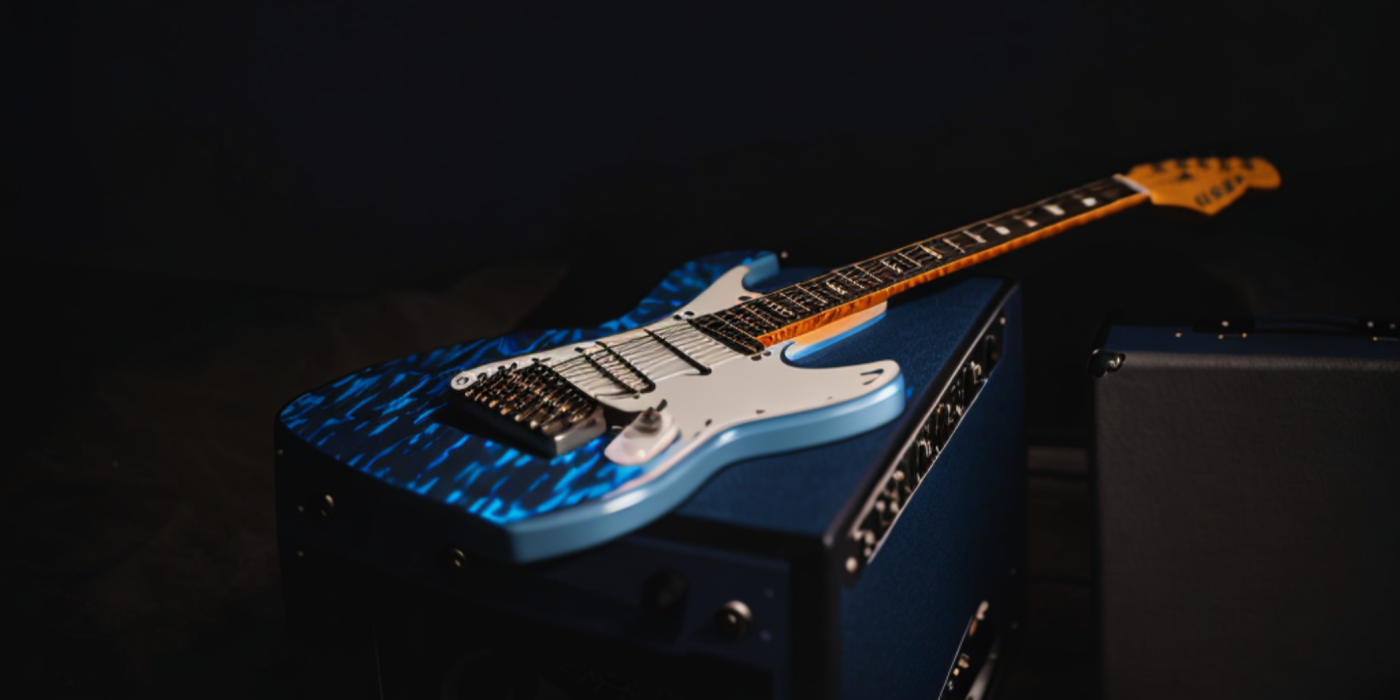From Headstock to Bridge: Exploring the Intricate Anatomy of a Guitar

Are you curious about the inner workings of a guitar and how each component contributes to its distinct sound? Look no further! In this captivating exploration, we will delve into the intricate anatomy of a guitar, from the headstock to the bridge. Whether you're an aspiring guitarist, a seasoned musician, or simply a lover of music, understanding the various parts of a guitar is essential for unlocking its full potential.
From the tuning pegs that ensure precise pitch control to the resonant body that amplifies sound, each element plays a vital role in producing those beloved melodies. Join us on this musical journey as we unravel the secrets behind the strings, frets, and everything in between. By the end, you'll have a deeper appreciation for the craftsmanship and engineering behind this timeless instrument. Get ready to be amazed by the fascinating world of guitar anatomy!
The headstock: Purpose and components
The headstock is the top part of a guitar where the strings are anchored and the tuning pegs are located. Its primary purpose is to hold the strings in place and provide a stable anchor point for tuning. The headstock also plays a crucial role in defining the guitar's aesthetics, as it often features the brand logo or other decorative elements. Additionally, the shape and design of the headstock can affect the guitar's overall balance and weight distribution.
Within the headstock, you'll find the tuning pegs, also known as machine heads or tuners. These mechanical devices are responsible for adjusting the tension of each string, allowing you to achieve precise pitch control. Tuning pegs come in various styles, including open-gear and sealed-gear, each offering its own advantages in terms of stability and ease of use. Some high-end guitars even feature locking tuners, which provide enhanced tuning stability by securing the string in place once it's properly tuned.
The nut is another vital component located at the end of the headstock. It is a small piece usually made of bone, plastic, or synthetic materials that holds the strings in their proper positions and defines the spacing between them. The nut's slots are carefully cut to ensure the strings sit at the correct height and angle, allowing for comfortable playing and accurate intonation. A well-cut nut is essential for maintaining proper string action and minimizing unwanted buzzing or string slippage.
The neck: Construction and features
The neck of a guitar connects the headstock to the body and provides support for the fretboard and strings. It is typically made of wood, with maple and mahogany being common choices due to their strength and tonal properties. The shape and profile of the neck can vary, with different guitar models offering different neck profiles to suit the player's preferences.
One of the key features of the guitar neck is the truss rod. Located beneath the fretboard, the truss rod is a metal rod that helps counterbalance the tension exerted by the strings. It allows for adjustments to the neck's curvature, ensuring optimal playability and preventing issues such as neck bowing or fret buzzing. Proper truss rod adjustment is crucial for maintaining the guitar's playability and preventing long-term damage to the neck.
The fretboard, also known as the fingerboard, is attached to the front of the neck and provides a smooth playing surface for the guitarist. It is usually made of wood, such as rosewood or maple, with a fretwire installed along its length. The fretboard is where the guitarist presses down on the strings to produce different pitches and create melodies. The choice of wood for the fretboard can affect the guitar's tonal characteristics, with different woods offering varying degrees of warmth, brightness, and sustain.
The frets: Types and positioning
The frets are metal strips embedded into the fretboard at precise intervals. They divide the neck into specific segments, allowing the player to produce different notes by pressing the strings against them. Frets are typically made of nickel or stainless steel, with stainless steel offering increased durability and resistance to wear.
The positioning of the frets is crucial for accurate intonation and proper playability. The placement of each fret is calculated based on the mathematical principles of equal temperament, ensuring that each note played on the guitar is in tune across all the strings. The accuracy of fret placement is essential for achieving harmonious chords and fluid melodic lines.
In addition to the standard frets, some guitars feature special types of frets for enhanced playability or unique tonal characteristics. Jumbo frets, for example, are larger than standard frets, making it easier to bend strings and perform techniques like vibrato. Stainless steel frets are known for their durability and resistance to wear, making them a popular choice among players who frequently bend strings or use aggressive playing styles.
The body: Shapes and materials
The body of a guitar is the large, hollow or solid structure that houses the pickups, controls, and bridge. It plays a crucial role in shaping the guitar's sound and determining its overall tonal characteristics. Guitar bodies come in various shapes and sizes, each offering its own sonic qualities and aesthetic appeal.
One of the most iconic guitar body shapes is the Stratocaster, which features a double-cutaway design and contoured edges for increased comfort and access to higher frets. The Stratocaster's body is typically made of solid wood, such as alder or ash, which contributes to its bright and versatile sound. On the other hand, guitars like the Les Paul have a single-cutaway design and a thicker, heavier body made of mahogany, resulting in a warm and sustain-rich tone.
Apart from the shape, the choice of wood for the guitar body can significantly influence its sound. Different types of wood have distinct tonal properties, with some being brighter or darker, more resonant or less resonant. For example, guitars made of mahogany tend to have a warm and rich tone, while those made of maple offer a brighter and more articulate sound. The combination of different woods and body shapes allows guitar manufacturers to create a wide range of sonic options to suit various playing styles and musical genres.
The bridge: Types and importance
The bridge is a crucial component of a guitar that anchors the strings to the body and transmits their vibrations to the soundboard. It plays a significant role in determining the guitar's sustain, intonation, and overall tonal characteristics. There are various types of bridges, each offering its own advantages and unique sonic characteristics.
One common type of bridge is the fixed bridge, also known as a hardtail bridge. As the name suggests, this type of bridge is fixed to the body and does not have any movable parts. Fixed bridges are known for their simplicity, ease of use, and excellent tuning stability. They are commonly found on guitars like the Telecaster or Les Paul.
Another popular bridge design is the tremolo bridge, also referred to as a vibrato bridge. This type of bridge allows the player to manipulate the pitch of the notes by moving the bridge up or down, creating shimmering vibrato or dive-bombing effects. Tremolo bridges are commonly seen on guitars like the Stratocaster or the Floyd Rose-equipped guitars.
The pickups: Single-coil vs. humbucker
Pickups are electromagnetic devices that capture the string vibrations and convert them into an electrical signal, which is then amplified and shaped by the guitar amplifier. They play a crucial role in shaping the guitar's tone and are available in different designs, each offering its own sonic characteristics.
One of the most common pickup types is the single-coil pickup, known for its bright and clear tone. Single-coil pickups are made up of a single coil of wire wrapped around a magnet. They have a bright and snappy sound that works well for genres like blues, country, or classic rock. Iconic guitars like the Fender Stratocaster are renowned for their use of single-coil pickups.
On the other hand, humbucker pickups consist of two coils wound in opposite directions, which cancels out the hum and results in a thicker and fuller tone. Humbuckers are known for their high output and ability to handle higher gain levels, making them popular among players of heavier genres like rock or metal. Guitars like the Gibson Les Paul are often equipped with humbucker pickups.
The controls: Knobs and switches
The controls on a guitar allow the player to adjust the volume, tone, and pickup selection. They are typically located on the body, within easy reach of the player's strumming hand. The exact configuration of controls can vary depending on the guitar model and manufacturer.
The most common control layout consists of volume and tone knobs, usually positioned near the bridge or pickup selector switch. Volume knobs allow the player to adjust the output level of the guitar, while tone knobs alter the frequency response, shaping the overall tonal character. Some guitars feature additional tone controls, such as dedicated knobs for each pickup or push/pull switches that activate coil-splitting options for added versatility.
Pickup selector switches are used to choose between different pickups or pickup combinations. They allow the player to access a variety of tonal options, from the bright and twangy sound of the bridge pickup to the warm and mellow tones of the neck pickup. Some guitars feature additional switches, such as coil-tap switches that disable one coil in a humbucker pickup, providing a single-coil-like sound.
Understanding the hardware: Tuners, nut, and saddle
In addition to the components mentioned above, there are several other hardware elements that contribute to the function and playability of a guitar. These include the tuners, nut, and saddle.
Tuners, also known as machine heads or tuning pegs, are located on the headstock and are used to adjust the tension of each string. They allow the player to tune the guitar accurately, ensuring that each string is at the desired pitch. Tuners come in various designs, from open-gear tuners with exposed gears to sealed-gear tuners that offer improved tuning stability.
The nut, as mentioned earlier, is a small piece located at the end of the headstock. It holds the strings in their proper positions and defines the spacing between them. The slots on the nut are carefully cut to allow the strings to pass through while maintaining proper string height and angle. A well-cut nut is crucial for accurate intonation and comfortable playing.
The saddle, located on the bridge, is responsible for transmitting the string vibrations to the soundboard. It is usually made of bone, plastic, or metal and is shaped to provide optimal string action and intonation. The saddle's height and positioning can be adjusted to fine-tune the guitar's playability and ensure that each string produces the desired pitch.
Exploring additional guitar components: Pickguard, strap buttons, and jack
Apart from the main components discussed so far, guitars often feature additional elements that enhance their functionality and convenience.
One such component is the pickguard, a protective plate usually made of plastic or other materials. The pickguard is located on the body, below the strings, and helps prevent scratches or damage caused by the player's pick. It is also a canvas for customization, allowing players to add their personal touch by choosing different colors or designs.
Strap buttons are small metal fixtures attached to the body of a guitar that allow the player to attach a guitar strap. They are usually located on the upper and lower ends of the body, providing stability and security while playing standing up. Some guitars feature locking strap buttons, which provide an extra layer of security by preventing accidental detachment.
The jack, commonly referred to as the output jack, is where the guitar cable connects to the guitar. It is usually located on the body, near the edge or on the lower bout. When a cable is plugged into the jack, the electrical signal from the pickups is sent to the amplifier, allowing the guitar's sound to be amplified and shaped.
Conclusion: Appreciating the intricate design of a guitar
In conclusion, the anatomy of a guitar is a fascinating combination of craftsmanship, engineering, and artistic design. Each component, from the headstock to the bridge, plays a vital role in shaping the instrument's sound, playability, and aesthetic appeal. Understanding the intricacies of guitar anatomy not only enhances our appreciation for the instrument but also empowers us to explore its full potential as musicians. Whether you're a beginner or an experienced player, taking the time to learn about the different parts of a guitar will undoubtedly deepen your connection with this timeless instrument. So, next time you strum a chord or hit a riff, remember the multitude of components working together to create those beautiful sounds. Let the intricate design of a guitar inspire you on your musical journey!
Related to this article are the following:
I do hope you have enjoyed this article and hope that you will subscribe to my newsletter so you can get the latest information about all things naturally relaxing.
Stay in touch, join the Naturally Relaxing Newsletter
Newsletter Signup
Post Your Comments
or post as a guest
Be the first to comment.
Latest articles in Music

Serene Symphony: Exploring 10 Timeless Classical Pieces for Unwavering Tranquillity

The Best Music for Meditation: A British Expert's Guide to Deepening Your Practice

The Best Music for Studying: An Expert's Guide to Optimal Concentration & Memory Boost

Melody & Dreams: The Musical Route to a Restful Night

The Healing Power of Music: Combatting Stress & Anxiety in Modern Britain






